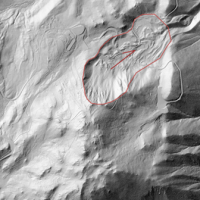The Reno hillsides offer some incredible views for those willing to tackle the geologic hazards that come with the territory. Landslides, faults, and complex geologic conditions can complicate just about any infrastructure or land development project. During the ice age, large landslides were commonplace in the mountains surrounding Reno. The destructive path of these landslides can still be seen as scars on the earth’s surface, including at the aptly named Slide Mountain. Although most of the larger landslides are now dormant, they can be hazardous if they are reactivated and start to move again. Landslide reactivation can pose a serious threat to construction crews and can even wipe out portions of an existing development.
For developers, it takes a good design team to find the engineering solutions to make projects viable and safe. Recent economic opportunities in Reno and high demand for new residences has pushed development up into the surrounding hills and terraces. To keep up with the demand, developers should engage experienced geologists and geotechnical engineers to identify these geologic hazards at the early stages of a project and to design solutions where safety is paramount. Oftentimes, the solutions for landslides involve earthwork operations to remove the unstable material. Alternatively, by mapping landslides early in the land planning process, they can frequently be avoided. Landslides can also trigger mudflows that can carry debris down drainage and impact homes, similar to the recent mudflows that occurred in the fire-scarred areas of the Western US.

Lidar Imagery of Slide Mountain
ENGEO, a west coast based engineering firm with an office in Reno, has used earthwork strategies for landslide mitigation for residential development projects in the Reno region. These techniques have included over excavating slide material, installing subdrains, designating debris catchment areas, buttressing, and even changing development plans to avoid large landslides.
In addition to landslides, tectonic forces in Nevada’s Basin and Range has resulted in hundreds of active fault segments throughout the Reno area. Understanding the location and activity of faults is crucial for planning developments, often establishing safe setback zones for buildings. ENGEO geologists have experience mapping and identifying faults so that the setback areas can be carefully and safely identified. This experience has been brought to multiple projects in Reno where ENGEO has identified active faults where setbacks are needed and also determined areas where fault features are old enough to not need setbacks, thus helping project feasibility.
Lastly, complex geologic formations often produce expansive soil, another significant hazard to development in the region. The Hunter Creek geologic formation in the uplands of Reno is known for having potentially destructive expansive soil. Expansive soil can swell with increases in moisture and develop high uplift pressures. The result can be uplift and damage to structures and severe cracking of roadways and sidewalks. Luckily, these problems can be avoided by simply replacing clay with granular, non-expansive soil or designing more robust foundations such as post-tensioned mats that can withstand the uplift forces. Because expansive soil can be hidden below the ground surface, subsurface exploration and lab testing becomes critical for identifying potentially expansive soil. This is where ENGEO geotechnical engineers and geologists get involved to investigate a site and find solutions that work long before construction begins. ENGEO recommendations for Reno residential projects have been able facilitate safe foundations and save substantial construction costs, helping bring more desperately needed housing to Reno.